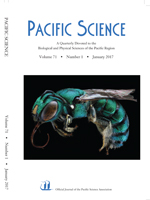Invasive bee species may have a widely detrimental impact on their novel host ecosystem. Introduced bees can rapidly disrupt native plant-pollinator mutualisms through competition with indigenous pollinator fauna and facilitation of invasive flora reproduction. Island ecosystems, which are inherently limited in physical range, resource availability, and trophic diversity, tend to be particularly sensitive to ecological impacts of invasive species. The small green carpenter bee Ceratina (Pithitis) smaragdula occurs throughout Southeast Asia and across the Hawaiian archipelago. Historical records indicate that C. smaragdula is nonnative to the Hawaiian archipelago and is recently introduced. Here we present a comprehensive synthesis of C. smaragdula's known biological and ecological history, as well as a population genetic analysis of C. smaragdula from Maui, and from locations across its native range, at the cytochrome oxidase I (COI) locus. We update C. smaragdula's known distribution and occurrence elevation in Hawai‘i and reveal a lack of genetic structure between Hawaiian and native range populations. We discuss points of origin, means of introduction, and potential ecological impact of this nonnative pollinator.
How to translate text using browser tools
1 January 2017
Range Expansion of the Small Carpenter Bee Ceratina smaragdula across the Hawaiian Archipelago with Potential Ecological Implications for Native Pollinator Systems
Wyatt A. Shell,
Sandra M. Rehan
ACCESS THE FULL ARTICLE

Pacific Science
Vol. 71 • No. 1
January 2017
Vol. 71 • No. 1
January 2017




